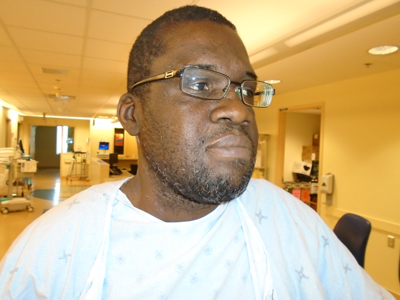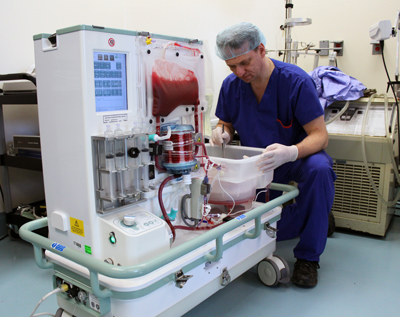
Clarence Mills, 43, is the first person in Ontario to receive a deceased donor liver which was kept healthy outside the body in a sterile medical device that allows the organ to repair itself. (Photo: UHN)
In an Ontario first, a deceased donor liver has been successfully transplanted after being preserved and kept healthy outside the body in a device that mimics human physiological functions.
The technique and device are part of a Phase 1 clinical trial at UHN's Toronto General Hospital (TGH) assessing the safety of the device, with subsequent phases examining its efficacy.
First developed at the University of Oxford, the device could potentially preserve a liver outside the body for up to 24 hours. Called the OrganOx Metra, it has been used successfully in liver transplantation in England, Spain, Germany, Belgium and Edmonton, Alta.
Clarence Mills, 43, received a deceased donor liver which was placed on the device for almost 12 hours.
"As I got sicker and sicker, it dawned on me that I might not make it," reflected Mills, who is very grateful to the deceased donor for giving him a second chance to live.
Ten different markers, or measures, such as production of bile and blood flow, were used to test the liver every hour, ensuring excellent functioning. In a six-hour operation earlier this month, the donor liver was implanted into Clarence, who is recovering well.
"I feel great," says Clarence, who was able to walk around the unit two days after his transplant.
Mills says he was happy to volunteer to become the first patient to receive a liver that was improved by the new technology. "I can make a difference to other patients by doing this," he says.
"Researchers can learn through me and my experiences, and that's worthwhile."
Dr. Markus Selzner, a transplant surgeon in the Multi-Organ Transplant (MOT) Program at TGH and co-investigator of the clinical trial, is the transplant surgeon who performed the deceased donor operation. The liver was placed on the device prior to its transplantation into Clarence.
"This technique will change the landscape of organ donation by improving organ preservation, allowing us to assess, or 'test drive,' the liver on the device before we transplant it into a patient," Dr. Selzner says. "We will know how healthy that organ is before the transplant operation.
Dr. Selzner, who is also a clinician-scientist at the Toronto General Research Institute, modified the Steen preservation solution used in the device at TGH and supervised the research and data gathered from the device at TGH. The new preservation solution decreases inflammation and protects the liver from injury. The liver is the second organ in the body which can regenerate, after skin.

Transplant surgeon Dr. Markus Selzner has refined a technique, first used in Oxford, England, to keep a deceased donor liver healthy outside the body for up to 24 hours using a sterile medical device, which is shown here. (Photo: UHN)
Dr. Selzner estimates that many more donor livers could benefit from this technology, since the technique and technology can potentially repair donor organs which are damaged by the current "cold storage" method of preservation. About 35 per cent of deceased donor liver organs are not suitable for transplantation.
The medical device encloses the liver in a sterile environment, circulating oxygenated blood and nutrients into the liver at body temperature, allowing it to improve and repair itself, potentially leading to better outcomes for patients. This technology has advantages over the usual cold storage method in which a deceased donor liver is cooled to about 4 C, with no oxygen, slowing down its metabolism, and inhibiting the repair process. The liver cannot survive longer than 12 hours in cold preservation.
"Even with the shortage of donor organs, we have to decline some of our donor organs because of the damage they sustain in the retrieval process," says Dr. David Grant, Surgical Director of the MOT Program. He was a co-investigator of the clinical trial and also transplanted the donor liver into Clarence.
"This new technology can help us answer critical questions such as, 'Can we use organs which we currently decline? Can we repair and predict organ function before the transplant occurs?'" he says.
Dr. Grant also praised the strong support and efforts of Trillium Gift of Life, which co-ordinates organ and tissue donation across Ontario, in helping to ensure that the transplant team could begin their clinical trials with this new technique.
The technique of warm organ perfusion outside the body was pioneered in the Toronto Lung Transplant Program at TGH in 2008 by Drs. Shaf Keshavjee and Marcelo Cypel in order to better treat, repair and assess high-risk donor lungs outside the body.
In that technique, the lungs are placed in a protective dome in which a system continuously pumps a bloodless solution of oxygen, proteins and nutrients into the injured donor lungs, mimicking normal physiological conditions. This makes it possible for the injured cells to begin repairing themselves, and sets the stage for more sophisticated repair techniques to be applied to donor lungs.
Since 2012, there has been a 28 per cent increase in lung transplants at TGH as a result of this system.
At any point in time, there are about 1,500 patients waiting for a transplant in Ontario. More than 200 of these wait for a liver, and about 30 per cent of patients die while waiting for a liver.
